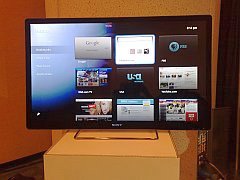
Updated 25-May-2010: Froyo availability information updated including links to Froyo ROM downloads. Corrected: Streaming non-DRM music over the air from your PC to the phone is a future release feature and is NOT in Froyo.
As expected yesterday’s Google I/O announcements were all about Android. Android OS 2.2 code named FroYo (“Frozen Yogurt”), and Google TV, which runs Android, were announced. Neither is available to yet.
FroYo: Google is certainly raising the bar with Android 2.2. The major new features in the release are:
- Flash 10.1 and Adobe Air support is included. That’s full desktop Flash support optimized for mobile devices. To be able to run Flash the phone must have a Cortex-A8 processor (currently only the Droid, Evo, Incredible and Nexus One).
- New enterprise features including Exchange Calendar synchronization, support for Exchange security features, and API’s that let enterprise developers implement things like remote wipe, remote locking, password aging and password complexity rules.
- An application data backup API: apps will be able to back up their data to the cloud so that when you switch devices you can restore the app AND its data.
- A cloud to device API that lets web services trigger Android Intents on the device. This means that a cloud service or desktop web page will be able to do things like send a Google Map or directions to the phone, or open the browser to show specific web content.
- Performance, performance, performance: Thanks to a new just-in-time Dalvik compiler, the FroYo OS and apps are up to 5 times faster than in Eclair. In addition, FroYo uses Chrome’s V8 JavaScript engine which speeds up JavaScript execution 3X At the keynote, Google showed FroYo soundly beating the iPad in the SunSpider JavaScript benchmark. Google CTO Vic Gundotra called the FroYo browser the world’s fastest mobile browser.
- Apps2SD: Applications can now run off the memory card.
- Tethering: Support for USB tethering and mobile hotspot. At the keynote Gundrota tethered an iPad to an Android mobile hotspot. But don’t count on these features working on your phone as operators will be able to disable them.
- Update All: The ability to apply all available application updates with a single click and to enable apps to update automatically
- Better Voice Recognition: Voice recognition now supports Japanese, Mandarin and variuos dialects of English (US, UK, Canadian, Indian, Australian). It can now parse complex natural language queries like “pictures of Barak Obama with the French president at the G1 summit”.
- Bluetooth Voice Dialing: Finally!
- Report A Bug with a new button on Android’s “Force Close” dialogs.
- Adsense for Mobile Apps: In app advertising for Android. It supports multple formats including text ads, graphical banners, video ads, click to call, click to download and a new expandable drop-down ad format.
There were also some features demoed that are not in FroYo but will appear later:
- New JavaScript API’s will let web apps do voice recognition or use the camera, accelerometer or speech synthesis.
- Android Market on the desktop: Sometime after FroYo ships, Google will launch a desktop web version of the Android Market which will let you purchase apps on your PC and have them pushed wirelessly to your phone.
- Voice recognition that understands users intentions and acts on them. In the demo Vic spoke “Call Fifth Floor Restaurant” and the phone placed the call.
- Music Streaming: Stream non-DRM music over the air from your PC to the phone.
See the Android Developers Blog for more details about FroYo features.
Availability: The FroYo SDK, which includes an emulator, is available now. Device updates should start rolling out next month with the Nexus One likely to be the first handset to receive FroYo. Update: Google started rolling out Froyo to a limited number of Nexus One users on June 22. It’s a phased rollout and it may take a couple of weeks before all Nexus One users get the update. If you can’t wait Android Police have the 2.2 ROM and instructions for updating.
At the Android Fireside Chat at I/o one of the developers mentioned the except for the HTC Dream/G1, which doesn’t have enough flash memory to hold the OS, all Android phones are technically able to run 2.2. If and when a given handset gets FroYo is up to device manufacturers and operators. You can be sure that the vibrant Android hacker community will soon have Froyo ROMs available for all rooted devices, even the G1.
Although the jump from 2.1 to 2.2 sounds like an incremental upgrade, feature wise FroYo looks like a major release, clearly targeted at Apple. Most of the new features: Flash, tethering, over the air app deployment, audio streaming and the Market web app are things that the iPhone lacks. Over and over at the keynote Gundrota and other speakers took digs at the iPhone and iPad without actually mentioning Apple’s name. A few examples;
- Gundotra quoting Andy Rubin as saying that he created Android to avoid “... a Draconian future, a future where one man, one company, one device, one carrier would be our only choice.“
- The cloud-to-device messaging API is not “..designed to compensate for the lack of basic functionality like multitasking in the operating system.“
- “It turns out that on the internet people use Flash. Part of being open means you are inclusive, rather than exclusive.”
Steve Jobs has his work cut out for him when he introduces the new iPhone next month.
Just to be sure everyone at I/O was sufficiently jazzed up about Android, every attendee was given an HTC Evo “superphone” with 30 days free service from Sprint. The lines to pickup the phones (image below) were enormous but moved very quickly. I spent most of yesterday afternoon and evening playing with mine and have to say it’s a fantastic device, amazingly fast and smooth with a beautiful 4.3 inch 800×480 screen and 8MP camera. I’ll do a full review of the Evo soon.

Google TV: The longest part of the keynote was not devoted to Android but to announcing Google TV. It’s an Android based platform that will seamlessly combine the web and TV. That means things like using Google search to find TV shows or clicking a button while watching a TV travelogue to find related web content like a map, hotel or airline booking site or the current weather at the destination.
Google promises that the it won’t deliver “dumbed down internet” in Google TV. Instead, it will be the complete, open internet, Flash included, and navigable with a full keyboard and pointing device. A Google TV Android app will let you use your phone as a remote control and for voice searches.
Google TV won’t be released until this Fall in the US and next year worldwide. There’s clearly some work that needs to be done before this is market ready. The demo of Google TV at I/O was pretty much a disaster, with the system’s Bluetooth keyboard dropping the connection over and over again.
The first TV products, shipping in the fall, will be a set-top box from Logitech (below, left), a Sony TV set (below, right) and Blueray player also from Sony. Other partners in Google TV are Intel (Atom processor) BestBuy, Dish Network and Adobe. Pricing for the devices was not announced but the service itself will be free.


The Google TV code will be released as open source early next year. An SDK will be available shortly after the first device ships.
Your Daily Dose of Entertainment, now on the Internet The Web contains the entire entertainment industry. The relatively recent development in the Web world is the integration of television. You no more have to rely on your TV sets to watch your favourite programs. Television, since its advent, has ….
I’d be surprised if Google’s Javascript APIs were BONDI compliant.
I’ve never heard anything about BONDI compliance or support from Google, which is not an OMTP member.
Plus Google’s philosophy on API security seems quite different from BONDI’s. Google generally only requires that the user give permission to allow use of hardware or personal information. BONDI gives more power to OEMs and MNOs in defining allowed uses and capabilities.
Any idea if the new Javascript APIs are going to be BONDI compliant?